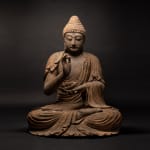Ming Dynasty Wooden Seated Buddha, 1500 CE - 1700 CE
Wood
106.7 x 87.6 cm
42 1/8 x 34 1/2 in
42 1/8 x 34 1/2 in
HK.2042
Further images
-
(View a larger image of thumbnail 1
)

-
(View a larger image of thumbnail 2
)

-
(View a larger image of thumbnail 3
)

-
(View a larger image of thumbnail 4
)

-
(View a larger image of thumbnail 5
)

-
(View a larger image of thumbnail 6
)

-
(View a larger image of thumbnail 7
)

-
(View a larger image of thumbnail 8
)

This is a very rare Ming dynasty wooden sculpture of Buddha Shakyamuni. Seated in lotus posture, the Buddha forms his hands in dharmacakra mudra, denoting his first sermon in the...
This is a very rare Ming dynasty wooden sculpture of Buddha Shakyamuni. Seated in lotus posture, the Buddha forms his hands in dharmacakra mudra, denoting his first sermon in the deer park. The Buddha has a narrow face and a voluminous physique. The transition from the Buddha’s hair and his ushnisha is smooth. The robes are depicted elegantly, with particular attention paid to the drape and folds on his lower body.
Wooden sculptures, often life-size or over, were common in north China from about the 11th to the 17th centuries. Their construction is particularly associated with Shanxi province, where the two preeminent centres of Buddhist activity were Taiyuan and Wutai shan. The style can generally be traced back to late 7th- and 8th-century Tang sculpture, as at the Tianlong shan caves, Taiyuan. Compared with the delicate-limbed deities there, these wooden figures are more fleshily modelled, with naturalistic faces and sometimes, as here, glassy, reflecting eyes; their voluminous yet relaxed bodies offer a compelling vision of the Buddhist ideal.
Wooden sculptures, often life-size or over, were common in north China from about the 11th to the 17th centuries. Their construction is particularly associated with Shanxi province, where the two preeminent centres of Buddhist activity were Taiyuan and Wutai shan. The style can generally be traced back to late 7th- and 8th-century Tang sculpture, as at the Tianlong shan caves, Taiyuan. Compared with the delicate-limbed deities there, these wooden figures are more fleshily modelled, with naturalistic faces and sometimes, as here, glassy, reflecting eyes; their voluminous yet relaxed bodies offer a compelling vision of the Buddhist ideal.







